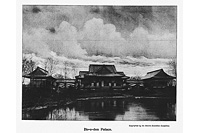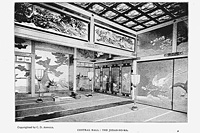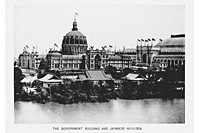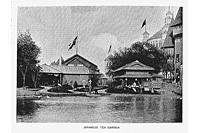Chicago International Exposition of 1893
Use of electricity
Column: Ho-o-Den (Phoenix Palace)
At previous international expositions, Japan set up tea stores and shrines to promote her culture to the world. At the Chicago International Exposition, however, the country constructed an authentic Japanese pavilion for the first time. Designed based on the Ho-o-Do (Phoenix Hall) of the Byodo-in Temple, the building was named Ho-o-Den (Phoenix Palace). It comprised three annexes created with the themes of the middle Heian period (ruled by the Fujiwara Clan), the Muromachi period (ruled by the Ashikaga Clan) and the Edo period (ruled by the Tokugawa Clan), emphasizing the great length of Japanese history.
The Chicago International Exposition was the largest yet held, and the United States was Japan's largest export partner at that time. Some documents by the Temporary Exposition Office suggest that Japan participated in the international exposition, striving to boost its national prestige and expand its exports by demonstrating its dignified culture, manners and customs, presenting its clear differences from China, and strengthening Japanese presence as a nation.
Ho-o-Den was designed by Masamichi Kuru, a pupil of J. Conder, an English architect. This was one of the first Japanese traditional structures designed by an architect who studied Western architecture. Also, prominent figures of Japanese art circles, such as Ryuichi Kuki and Kakuzo (Tenshin) Okakura, were engaged as members of the Temporary Exposition Office. While Tokyo Fine Arts School was in charge of the interior decoration, the Imperial Museum was responsible for the selection of arts and furniture items. Unlike at the previous international expositions that Japan had participated in before, at the Chicago International Exposition Japan did not merely display its items, but emphasized the recreation of each period with the current of Japanese art history. It can be said that this indicated Japan's pride in its own arts, the excellence of which the country had discovered anew.
Meanwhile, the United States as the host country sought to demonstrate to the world the country's relationship with Japan as a sworn ally, in a strong rivalry with the past international expositions held in Europe, and with consideration given to the economic and political situation of those days. Probably with this as a background, the Ho-o-Den was constructed on Wooded Island, one of the best locations among the exposition venues.
The Ho-o-Den drew public attention even while it was still under construction; many people visited the construction site to see the structure, sometimes interrupting its construction. After the opening of the international exposition, the Ho-o-Den was even more highly regarded, and many of the visitors commented that the structure was exotic and elegant. It is well-known that F. L. Wright was influenced by the Ho-o-Den. In addition to this structure, a tea store was constructed. All the items used at the store, from furniture to tableware, were Japanese products carried from Japan, and the store staff members were Japanese clad in Japanese attire, attracting further public attention. After the end of the international exposition, however, the Ho-o-Den, as well as other structures, was destroyed by a fire. Today, the site of the Ho-o-Den has been converted into a Japanese garden named the "Osaka Garden" after Osaka, the sister city of Chicago.
- References:
Kurokawa, Naoki.: 1893 nen shikago sekai hakurankai niokeru nihonkan 'Hooden' no shikichi kyoyo ni tsuite in Gakujutsu koen kogaishu F (1999.9) <Z16-107>
Mishima, Masahiro.: 1893 nen shikago bankokuhaku niokeru hooden no kensetsu keii ni tsuite in Nihon kenchiku gakkai keikakukei ronbun hokokushu n. 429 (1991.11) <Z16-107>
Rinji hakurankai jimukyoku hokoku (Rinji hakurankai jimukyoku, 1895) <YDM42219>
Sakamoto, Katsuhiko.: Dai 2bu: Kyu teikoku toshokan to ueno no mori no bunkateki sutokku - kindai kentiku hatten no nakade (ILCL's seminar commemorating the 100th anniversary of the construction of the Imperial Library) (https://www.kodomo.go.jp/event/event/event2006-08.html)





